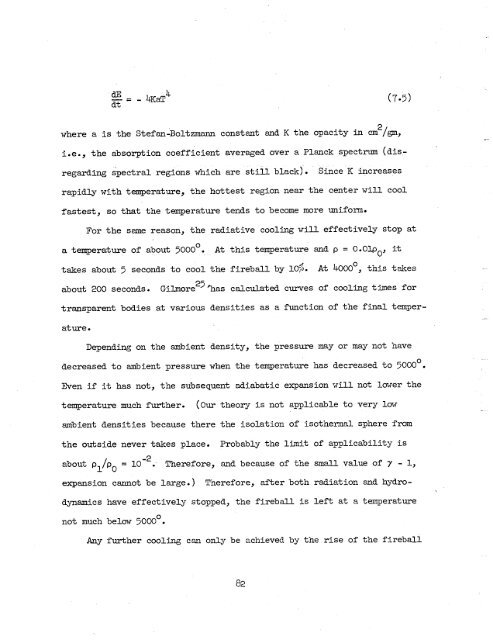Theory of the Fireball
Theory of the Fireball
Theory of the Fireball
You also want an ePaper? Increase the reach of your titles
YUMPU automatically turns print PDFs into web optimized ePapers that Google loves.
4<br />
dF: = - 4KaT<br />
at<br />
where a is <strong>the</strong> Stefan-Boltzmann constat and K tne opacity in cm /gm,<br />
(7.5)<br />
i.e., <strong>the</strong> absorption coefficient averaged over a PlaJnck spectrum (dis-<br />
regarding spectral regions which are still black) . Since K increases<br />
rapidly with temperature, <strong>the</strong> hottest region near <strong>the</strong> center will cool<br />
fastest, so that tne temperature tends to become more uniform.<br />
For <strong>the</strong> same reason, <strong>the</strong> radiative coolhg will effectively stop at<br />
a temperature <strong>of</strong> about 5000°. At t‘nis temperature and p = O.Olpo, it<br />
takes about 5 seconds to cool <strong>the</strong> fireball by LO$. At 4000°, this takes<br />
about 200 seconds. Gilmore2’ ‘has calculated curves <strong>of</strong> cooling times for<br />
transparent bodies at various densities as a function <strong>of</strong> tine final temper-<br />
ature.<br />
Depending on <strong>the</strong> ambient density, tne pressure may or may not have<br />
decreased to ambient pressure when <strong>the</strong> temperature has decreased to ‘OOOo.<br />
Even if it has not, <strong>the</strong> subsequent adiabatic expansion t rill not lower <strong>the</strong><br />
temperature much fur<strong>the</strong>r. (Our <strong>the</strong>ory is not applicable to very lar~<br />
ambient densities because <strong>the</strong>re <strong>the</strong> isolation <strong>of</strong> isotnermal sphere from<br />
t’ne outside never takes place. Probably <strong>the</strong> limit <strong>of</strong> applicability is<br />
-2<br />
about pl/po = 10 . Therefore, and because <strong>of</strong> <strong>the</strong> small value <strong>of</strong> y - 1,<br />
expansion cannot be large.) Therefore, after both radiation and hydro-<br />
dynamics have effectively stopped, <strong>the</strong> fireball is left at a temperature<br />
not much belov 5000°.<br />
Any furt‘ner cooling can only be achieved by <strong>the</strong> rise <strong>of</strong> <strong>the</strong> fireball<br />
82<br />
2<br />
.-
















